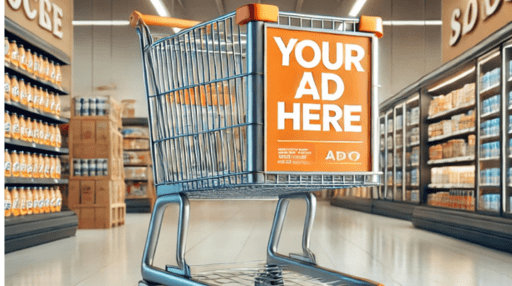In the dynamic world of grocery store marketing, businesses are continually looking for innovative ways to capture consumers’ attention and increase sales. As more grocery stores compete for customer loyalty, traditional advertising methods like print flyers, billboards, or radio ads often struggle to provide the kind of engagement needed to drive lasting impressions. To stay competitive, many grocery stores are turning to digital signage as a more effective advertising tool. But with the rising costs of implementing such technology, the question remains: is grocery stores ads using digital signage cost-effective?
In this blog, we’ll explore how grocery stores ads using digital signage can be a highly cost-effective strategy, why it works, and how stores can measure and maximize their return on investment (ROI). We’ll also look at how digital signage can be optimized for better consumer engagement and discuss metrics that matter for grocery stores investing in this technology.
What is In-Store Digital Signage?
In-store digital signage refers to the use of digital screens or interactive displays to convey promotional messages, product information, or advertising content within a store. These can range from static displays that show digital ads, to more dynamic, interactive kiosks that provide product details, offer discounts, or encourage customer engagement.
Compared to traditional advertising methods like print ads or flyers, digital signage allows grocery stores to target their audience more precisely, offer real-time promotions, and engage customers more directly.
Why Grocery Stores Ads Using Digital Signage Can Be Cost-Effective
When considering grocery stores ads using digital signage, it’s essential to weigh both the initial investment and the ongoing costs against the potential return. Below are several key reasons why digital signage can be a cost-effective solution for grocery stores.
Reduced Print Costs
One of the most significant cost savings when using digital signage for grocery store ads is the reduction in print costs. Traditional advertising methods, such as paper flyers, posters, and coupons, require recurring costs for printing, distribution, and storage. Digital signage, on the other hand, allows for the easy and instant update of promotional content without any physical printing.
Real-Time Content Updates
One of the main benefits of grocery stores ads through digital signage is the ability to update content in real-time. Traditional ads often require a significant lead time to print, distribute, and replace, which means they may no longer be relevant by the time they reach consumers. With digital signage, stores can update ads instantly to reflect stock changes, new promotions, or time-sensitive offers.
The ability to change messaging on-demand ensures that the content displayed is always relevant and accurate, increasing the chances of driving sales while keeping costs in check. This ability to update content as needed makes digital signage a far more flexible and dynamic advertising option compared to static print ads.
Increased Consumer Engagement and Impulse Purchases
Digital signage has been shown to increase consumer engagement by providing visually dynamic content that captures attention. In grocery stores, where customers are often bombarded with information, grocery stores ads on digital screens can break through the noise and drive greater engagement.
When done strategically, grocery stores ads on digital signage can significantly increase sales by capturing consumer attention and nudging them toward making additional purchases. This type of engagement is particularly powerful in high-traffic areas like the checkout lanes or entrance, where customers are most receptive to these last-minute prompts.
Better Targeting with Data Integration
Another way grocery stores ads using digital signage can be cost-effective is through the ability to personalize ads based on consumer data. Digital signage can be integrated with customer data platforms, allowing stores to serve tailored content to specific segments of their audience.
Targeting the right content to the right consumers makes the advertising more effective, improving ROI and reducing wasted ad spend. This personalized approach ensures that the store’s advertising budget is being used efficiently and that the messages are aligned with customer preferences.
Long-Term Sustainability and Energy Efficiency
Digital signage is also a more sustainable advertising method compared to traditional print ads. While printing paper ads requires the use of natural resources and generates waste, digital signage is a much more eco-friendly option. The screens themselves use far less energy than traditional lighting and print production, and the content can be recycled or updated without the need for additional physical resources.
Measuring the ROI of Grocery Store Ads Using Digital Signage
While the benefits of grocery stores ads using digital signage are clear, it’s important to measure the return on investment (ROI) to ensure the costs are justified. There are several key metrics that grocery stores can use to evaluate the effectiveness of their digital signage campaigns:
Engagement Metrics
One of the easiest ways to measure the effectiveness of digital signage is by tracking engagement. This can include monitoring how often customers engage with interactive displays or how long they spend looking at digital ads. Data from customer loyalty programs and mobile apps can also be used to track which promotions are leading to higher purchases.
Sales Metrics
Sales data is another critical metric for measuring the success of grocery store ads using digital signage. Track how specific promotions or products featured on digital screens impact sales figures, and compare them to sales from previous periods when no digital signage was used.
Customer Feedback
Another way to gauge success is through customer feedback. Surveys or focus groups can be used to determine how customers perceive the digital displays. Are they finding the ads helpful? Do they feel more engaged with the store because of the dynamic content? Positive feedback is a good indicator that the digital signage is effective.
Conversion Rates
Finally, conversion rates can provide valuable insight into how well grocery stores ads are driving actions. For example, if a digital sign advertises a special promotion, how many customers who saw the ad end up purchasing that specific product? Measuring conversions gives a clear picture of how well the advertising is performing.








